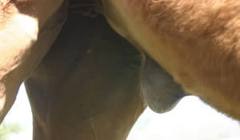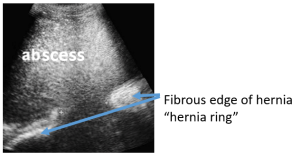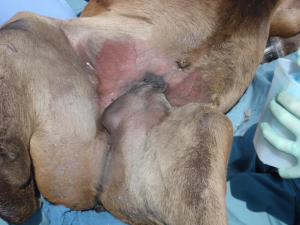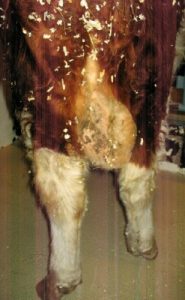Large animal masses
Hernias
The most common hernias are umbilical and inguinal.
Umbilical hernias
Umbilical hernias can occur due to a genetic predisposition, an umbilical infection, or, more rarely, umbilical trauma. Occasionally body wall trauma will lead to an “umbilical” hernia and incisional hernias often include the umbilical region. We will focus on the neonatal ones.
Most umbilical hernias are reducible and a hernia ring (firm tissue around the edges of the hernia) is palpable. Unless infection is present, the hernia should be cool and non-painful. Most umbilical hernias are present from a very young age. Quarterhorse fillies are genetically predisposed as are certain lines of Holsteins and pigs. If you do not see signs of infection, it is worth coaching your client about the likely heritability, particularly in those groups. Many simple hernias in foals will resolve over the first two months of life; it is worth waiting until the foal is weaned before considering hernia repair. Hernias have not been reported to resolve as often in cattle and swine.

In many calves, the hernia develops because an umbilical infection precludes normal closure. Infection can develop in any of the umbilical structures (arteries, vein or urachus). These are also generally reducible but may have purulent discharge and/or heat and pain associated. Ultrasound may be helpful to identify a gap in the body wall and/or what structure is infected. Umbilical abscesses without an associated hernia can be treated as regular abscesses. Otherwise, the infection can be removed en bloc (as a closed unit) at the time of hernia repair. [I find this quite tricky and do drain the infection first; I do surgery a few days later. This minimizes accidental rupturing of the abscess as you are trying to remove it.]

If a hernia develops due to trauma, it is essential to wait until a fibrous hernia ring develops prior to attempting repair; this usually takes about 60 days. This ring will hold the suture much more effectively than muscle.

Exception: if the intestines are “stuck” in the hernia and the hernia is not reducible, this is an emergency.
Inguinal hernias
Inguinal hernias present quite differently depending upon the age of the patient. Adult horses with inguinal hernia are emergencies and often require surgery to remove the intestines from the hernia; the intestines can become devitalized quite quickly.
Foals and calves with inguinal hernias are typically not an emergency. The intestines slide around and can be shoved back into the abdomen (but quickly slide back out). These usually resolve on their own over time. However, it is possible for the intestines to become stuck in the hernia. If the intestines become stuck, emergency surgery is needed.

Adult bulls with hernias are typically not an emergency. These are associated with large fat pads in the inguinal ring that protect the intestines. However, fertility is impaired because of the heat generated by the extra things in the scrotum. Repair usually involves hemicastration and closure of the ring.


